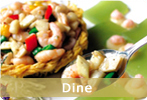Cantonese cuisine ranks among China's top four cuisines and is comprised of Guangzhou cuisine, Chaozhou cuisine, and Dongjiang cuisine. Guangzhou cuisine is the quintessential form of Cantonese cuisine.
Guangzhou cuisine has evolved into its' unique form by integrating folk delicacies from throughout Guangdong Province, absorbing the strong points of all major Chinese cuisines and drawing on selected strengths of Western recipes. It is characterized by the diversity of the ingredients used, the rigor of their selection, the polished culinary skills applied and a seemingly endless variety of dishes. The Guangzhou Renowned Dishes and Delicacies Expo in 1956 featured more than 5,447 dishes as well as 815 dim sum platters and hundreds of snacks.
Guangzhou cuisine uses as many as 21 cooking techniques notably stir-frying, pan-frying, deep-frying, simmering, stewing, and braising, placing a strong emphasis on the control of the heat applied and on the texture, fragrance, flavor and form of dishes prepared.
Its notably attributes are the clearness of the ingredients, the refreshing qualities of the dishes and the tenderness and crispness of the plates prepares. It emphasizes flavors which are clear but not light, refreshing but not common, tender but not crude, and shiny but not oily. Cantonese recipes stress flavors of the seasons: in summer and autumn the dishes pursue clarity and in winter and spring there is more substance.
Guangzhou Wenchang Chicken
The word "Wenchang" in "Guangzhou Wenchang Chicken" has two historical references: First, the chicken used was originally a high-quality chicken from Wenchang County in Hainan Province; and Second, the first Guangzhou restaurant offering this dish was located on Wenchang Road in Guangzhou City. During the 1930s Guangzhou master chef Liang Ruijiang created this ingenious dish by removing the bones and boiling, steaming and frying the chicken meat with ham and chicken liver. By doing so, he made the best use of the ingredients and bypassed their disadvantages resulting in the perfect chicken dish. Over the past decades, Wenchang Chicken has gained popularity in China and beyond. Today, it ranks among Guangzhou's top eight chicken dishes.
Fried Chicken Feet with Oyster Oil
Guangdong's citizens are fond of chicken feet and prepare them in various ways. This dish features meticulous cooking techniques. The feet are first boiled, then fried and finally braised until they turn an attractive golden color.
"Unicorn" Perch
The main ingredient of this dish is perch or other freshwater fish and its auxiliary ingredients include ham, winter mushrooms and fatty pork. The ingredients are prepared in a steamer basket with the elements of the dish being artfully overlapped to resemble the scales of a unicorn.
Sliced Suckling Pig
This dish features a suckling pig prepared with a bright red, oily textured skin and tender meat. Its unique flavor has earned it wide popularity. Roasted suckling pig is one of the grandest dishes for the people of Guangdong and Guangxi Provinces and is served when entertaining guests at home or in a restaurant.
Huadiao Chicken
One of the top eight chicken dishes in Guangzhou, Huadiao Chicken, is a highlight of the Guangzhou Beiyuan Restaurant. It is stewed in an earthen pot with the heat being transmitted through the grease seeping from fried fat. A small amount of juice and Huadiao liquor is added to the pot to facilitate cooking.
Fried Young Chicken
A classic chicken dish of Cantonese, Fried Young Chicken features crisp skin and tender meat making it a must-have dish for wedding banquets.
Cantonese-Style Roasted Duck
In this dish the duck features an eye-pleasing golden color, crisp skin and fragrant meat.
Dragon-King Appetizer Plate
In this dish, shrimps are prepared to be tender, fresh and fragrant and are offered with different seasonings that can be added to suit different tastes.
Steamed Minced Pork with Salted Eggs
A duck egg which has been salted for an extended period of time is mixed with minced pork and steamed to make a pork pie. This is a common family dish throughout Guangdong.
"Hundred Flower" Fish Maw
Fish maw has soft bones and is white in color and has a fresh and tender taste. The fish maw, the air bladder of the fish, is the organ that allows fish to float and to sink. For this dish the air-dried maw is typically from sharks and giant salamanders and is one of the top four seafood dishes. Fish maws are produced in China's coastal areas, the most prominent of which is Guangdong's "Guang maw".
Snake Potage with Eight Delicacies
Guangzhou's snake restaurants have a long history and enjoy immense popularity. The "Snake King Fullness" Restaurant, the top snake restaurant in Guangzhou, is noted for its dishes prepared using various techniques. Snake Potage with Eight Delicacies, a classic dish offered by clients of this restaurant, features a strong fragrance and is effective in renowned for relieving rheumatic pains, eliminating dampness in the body, invigorating the spleen and replenishing energy.
Shelled Prawns in Oil
Shelled prawns are mixed with raising powder and egg white, then salted and refrigerated finally being boiled in hot oil. This dish retains the flavor of fresh prawns while presenting a tender taste and crisp texture.
Stewed Whole Shark Fin in Brown Sauce
The fin used is typically a dried shark fin. In this dish the fin used is a complete shark fin. In Cantonese cuisine, shark fins are classified into three types: primary fin, the front fin close to the shark's head; the secondary fin, the rear fin near the shark's tail; and the tertiary fin, the tail fin on the shark. The primary fin, which is typically used in this dish, is considered the best of all.
Baiyun Trotter
This dish is reputed to have originated on the Baiyun Mountain and hence, gets its name. In this dish the bone and flesh on the trotter are easily separated and its skin being tender and the flesh crisp. This dish goes very nicely with wine and is said to improve the complexion and maintain a sense of youthfulness.
White cut chicken
White cut chicken is a traditional, common chicken dish in Cantonese Cuisine with great presentation and taste. It is easy-to-make and cooked in its entirety in hot water without other ingredients to keep its original flavor. White cut chicken is light and delicious. The chicken’s skin is light colored, nearly white and the meat is quite tender, moist, and flavorful. A condiment usually accompanied by combining finely minced ginger, green onion, salt and hot peanut oil. Additional dips can be spicy mustard, hoisin sauce, soy sauce, oyster sauce, or chili pepper sauce. The famous Panxi Restaurant white cut chicken was once awarded the Jingding Award for high quality products by the Ministry of Commerce.
White boiled shrimp
White boiled shrimp is a famous Cantonese dish of the Han nationality in Guangzhou, Guangdong Province. Its main ingredient is shrimp which is boiled in hot water to preserve its original flavor of freshness, sweetness and tenderness. After peeled, the shrimp is then eaten with soy sauce. White boiled shrimp is fresh, tender and delicious.
Cha siu bao (dim sum)
Cha siu bao is one of the representative, traditional dim sums of the Han Nationality in Guangdong Province. It is also one of the four major dim sums of the Cantonese style morning or afternoon tea, and the other three are shrimp dumpling, Shumai and egg tart. It is named so because of its cha siu pork stuffing. Its dough is made from fermented dough usually used in the north. Cha siu bao is made bird cage shaped, because after proper fermentation, the top of the bun would naturally crack when it is steamed well. In fact, it is kind of like the flowering steamed bun with cha siu pork stuffing.
Cha siu pork
Cha siu pork is a traditional Cantonese dish of the Han Nationality in Guangdong. It is classified as a type of siu mei, Cantonese roasted meat. It has a red exterior and slightly sweet flavor and is made of lean pork. Long strips of seasoned boneless pork are skewered with long forks and placed in a covered oven or over a fire. High-quality cha siu pork should be tender and juicy with bright color and rich fragrance. Among them, the one with balanced fat and lean pork is the best.
Rice noodle roll
Rice noodle roll is a special snack originated in Guangdong. Early in the late Qing Dynasty, rice noodle roll was sold on the street in Guangzhou. At that time, there were two types of rice noodle roll, the salty one and the sweet one. The stuffing of the salty rice noodle roll mainly includes pork, beef, shrimp meat and pork liver, while that of the sweet one mainly includes sugar-soaking vegetables and fruits and stir-fried sesame. Rice noodle roll is also known as steamed rice roll or chee cheong fun where chee cheong means pig intestine, and fun means noodle; this is because the noodle is rolled more tightly and resembles the small intestine of a pig. Rice noodle roll in Chaoshan area is different from the traditional Cantonese style one. Chaoshan rice noodle roll has many kinds of stuffing and condiment, while traditional Cantonese style one has only one or two kinds of stuffing and soybean sauce as the condiment, so its flavor is lighter and purer.
Sweet and sour pork
Called “goo lou yok” in Cantonese dialect, sweet and sour pork is a classic dish of the Han Nationality originated in Guangdong. The dish consists of deep-fried pork and sweet and sour sauce and it is one of the most popular Chinese dishes in western countries. Many restaurants in China Towns all over the world often serve sweet and sour pork along with rice or fried rice. It is said that the name of “goo lou yok” came from two stories. In the first story, as the dish is cooked with sweet and sour sauce, its fragrance makes people’s mouths water and couldn’t helping swallowing, and “goo lou” is the exact sound of swallowing. The second version gives credit to the long history of this dish for “goo lou” is a homonym in Chinese language that means “old and ancient”.
All materials marked with "source: English.gz.gov.cn" on this website (including but not limited to text, photographs, audio and video materials) are the copyrighted property of Guangzhou International (the official website of Guangzhou Municipality). Without prior authorization from Guangzhou International, any media, website, organization or individual shall not transmit, interlink, distribute or republish such materials in any form. Any media and website authorized to republish such materials shall mark them with "source: Guangzhou International (English.gz.gov.cn)". Infringement of these copyrights will result in legal action.






